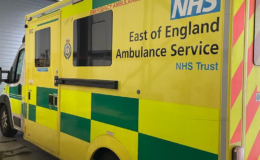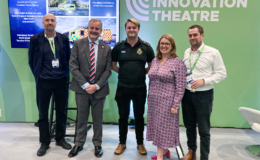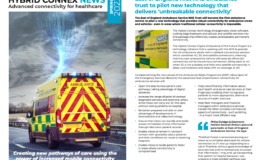The East of England Ambulance Service NHS Trust will become the first ambulance service to pilot a new technology that provides robust connectivity for ambulance crews and vehicles – even in areas where traditional cellular connectivity is impossible.
The Hybrid Connex technology amalgamates clever software, cutting-edge hardware and cellular and satellite services into one package that effectively creates unbreakable, permanent connectivity.

The Hybrid Connex Digital Ambulance of the Future Project is a technology initiative that is working with the NHS to provide the UK ambulance sector with a resilient connectivity solution which combines 4G, 5G and satellite connections, meaning that the crew onboard the vehicle will never be offline (5G connectivity will be the primary connection, falling back to 4G when 5G is not available and then onto satellite connectivity in deep rural locations and areas with no coverage at all).
Complementing the next phase of the Ambulance Radio Programme (ARP) rollout (part of the Emergency Services Network) this advanced level of permanent connectivity for ambulance services will:
- Open the door to new patient care pathways, taking advantage of digital advances.
- Increase the range of point-of-contact diagnostic services and tests that ambulance crews can carry out on-the-spot, without taking patients to hospital.
- Be better prepared and able to take advantage of developments in telemedicine and video technology.
- Ensure that crews can quickly and easily access immediate clinical information through electronic patient records.
- Enable crews to remain in constant contact with specialists about patients and their conditions en-route to receiving hospitals.
- Enable crews to locate patients faster in areas where connectivity is compromised.
- Help crews find key information about local health and social care services at their fingertips, enabling them to signpost patients to more appropriate, alternative sources of health and care.
- Help fleet managers and financial managers within ambulance services handle the often-complex commercial aspects of connectivity – such as billing – in a much more efficient way.
Philip Elvidge is Electronic Patient Record Clinical Lead and paramedic at East of England Ambulance Service. He says:
“Thetford Forest is renowned among our crews as a complete dead spot for cellular connection so if I end up responding to a call in Thetford, without good knowledge of local services and no connectivity to access that information, I may end up transporting that patient to hospital because I was unaware a more suitable pathway was available.
“Another issue we face is how poor connectivity affects the telemetry on our cardiac monitors. For example, if you were diagnosing an MI [myocardial infarction] in a connectivity black spot you couldn’t then send the ECG off to a specialist consultant for review of the ECG changes prior to our arrival. I’ve had this exact issue in the past in areas where there has been very limited cellular connection. You find yourself having to drive up the road and around the corner to find a location where you’re able to send the ECG successfully. It wastes valuable time which is vital to the patient.”
Stroke is another key pathway where permanent connectivity could significantly improve patient outcomes.

Says Philip: “With a solid connection we can have a genuinely effective video triage meaning the consultant can better assess the patient to rule in or out a stroke mimic. Those assessments are supposed to be rapid – less than ten minutes – there isn’t time to waste trying to get connected as the patient could deteriorate quickly – and if the specialist decides it is a stroke and not a mimic, we need to be on the road to a stroke unit and getting them treatment as soon as possible.”
Another positive of having permanent connectivity within the ambulance vehicle is that it enables staff to catch up on their Continued Professional Development (CPD) during times when they would otherwise simply be waiting, for example during extended hospital handover delays.
The pilot will involve six East of England ambulance vehicles and will be operational between August and October 2023, after which it will be fully evaluated and if successful, offered as a service to ambulance trusts.
Other UK ambulance services are also currently being encouraged to pilot test the new technology completely free of charge.
Hybrid Connex is a €5.7m research and development initiative co-funded by the European Space Agency (ESA) ARTES 5G Strategic Programme Line (SPL) and the UK Space Agency (UKSA) to create the prototype for pioneering an always-connected and cloud-based digital ambulance of the future. It is being delivered by a consortium of partners led by UK emergency services connectivity specialists Excelerate Technology and includes NHS Arden and GEM, Livewire, the Satellite Applications Catapult and Vodafone.
Bethan Evans, Chief Operating Officer at Excelerate Technology says: “We are delighted to be working with East of England Ambulance Service and we hope to prove how this superior level of connectivity will enable all regional ambulance services to achieve so much more with technology, whether that is for the improvement of patient care or to achieve greater efficiency in their performance. The resilience of the connection that we can now achieve is leading edge teachnology that is being adopted in the most advanced parts of the world and we can now deliver that capability to our emergency services customers in the UK, the ambulance sector and its patients being the primary beneficiary.”
To find out more visit www.hybridconnex.co.uk or contact bethane@excelerate.info.





